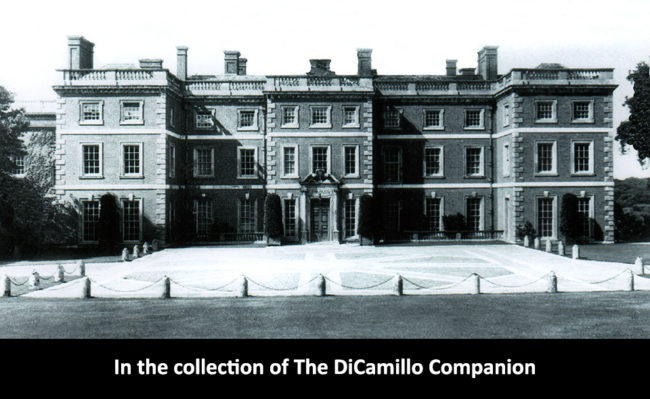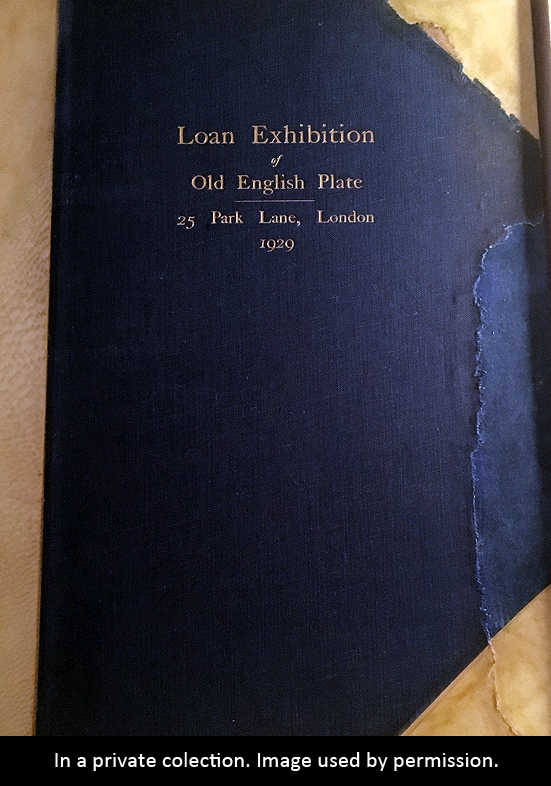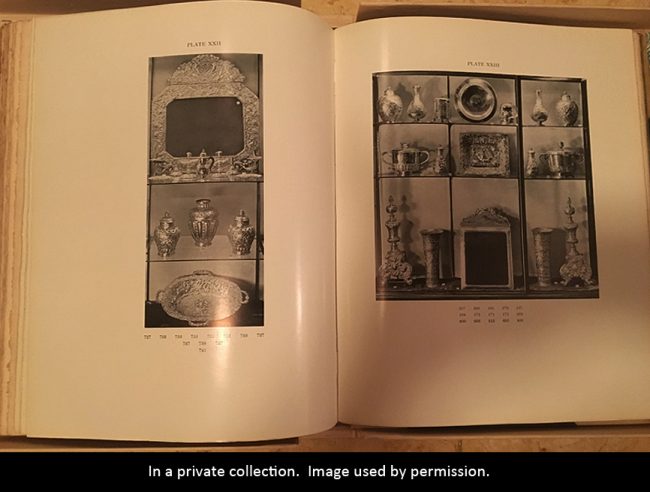
The House from a circa 1925 postcard

Cover of Philip Sassoon's 1929 old English silver exhibition catalog

Pages from Philip Sassoon's 1929 old English silver exhibition catalog
Earlier Houses: An earlier house, altered circa 1777 to the designs of Sir William Chambers for Sir Richard Jebb, existed on the site. Parts of this house may have been incorporated into the current house, though Howard Colvin says it was demolished.
House & Family History: Today's Trent Park dates to the 14th century, when it was part of Enfield Chase, one of King Henry IV's hunting grounds. In 1777 King George III gave the estate to Richard Jebb (later Sir Richard) as a reward for saving the life of the king's younger brother, Prince William Henry, Duke of Gloucester. The name Trent was chosen for the estate because it was in Trent, Italy, that the king's brother had been saved by Jebb. Circa 1836 Trent was purchased by the banker David Bevan for his son, Robert Cooper Lee Bevan, on the occasion of his marriage to Lady Agneta Yorke. In 1909 Sir Philip Sassoon purchased Trent. Though no architect is known to have officially worked on the house, it seems likely that Philip Tilden advised Sir Philip on the alterations. In his autobiography Tilden writes about Sir Philip: "He was, I think, above all else obsessed with things rather than with people. I do not think, either, that a more brilliant man for his age existed than Philip...intensely amusing and amused...His taste was sometimes exotic." During the roaring twenties Trent was the center of lively entertaining, with many of the Bright Young Things in frequent attendance, as well as more sedate types, such as Winston Churchill and the Prince of Wales (later King Edward VIII), who visited Sir Philip here in 1920. Sir Philip Albert Gustave David Sassoon, 3rd Bt. (1888-1939), was a scion of the Jewish-Baghdadi mercantile family who were known as the "Rothschilds of the East." The Sassoons emigrated from Bombay (where they made the core of the family fortune) to London in the 1850s. The family firms, David Sassoon & Co. and E.D. Sassoon & Co., continued to function until just after World War II. Philip's father was Sir Edward Albert Sassoon, 2nd Bt., MP, son of Albert Abdullah David Sassoon; his mother was Aline Caroline Rothschild, daughter of Baron Gustave de Rothschild. Philip was a second cousin of the poet Siegfried Sassoon and his sister was the famous Sybil Sassoon, who married George Cholmondeley, Earl of Rocksavage, later 5th Marquess of Cholmondeley. Philip served as private secretary to Douglas Haig during World War I and as parliamentary private secretary to Lloyd George after the war. He was first elected as MP for Hythe in 1912; served again between 1924 and 1929; and then again from 1931 until 1937, when he served as under-secretary of state for air. In 1937 Philip became the first commissioner of works, a post which he held until his death two years later. Philip was one of the great esthetes of the early 20th century. He was a magnificent collector, a trustee of major museums in Britain, the organizer of ten influential exhibitions, and a patron of John Singer Sargent, among other artists. Philip usually displayed his exhibitions at his London home at 25 Park Lane, the March 1929 "Loan Exhibition of Old English Plate" being a prime example (see photos of this exhibition catalog in the "Images" section). He usually also financed luxurious catalogs to accompany the exhibitions. During World War II Trent was used as a prison for captured German generals and staff officers. During this time many of the rooms in the house were equipped with hidden microphones and listening devices, enabling the British military to gather important information from the German military elite. After the war the estate was acquired by the local council; in 1951 the house became Trent Park College, which became part of Middlesex Polytechnic in 1978 and, in 1992, the Trent Park campus of Middlesex University. The university vacated the house in 2012; Trent Park was sold in 2013 for £30 million to Malaysia's Allianze University College of Medical Sciences. The university closed in 2014 and Trent Park was sold to Berkeley Homes, who redeveloped the house into luxury flats, with the first floor and basement set aside for the Trent Park Museum Trust, who plan to open a museum dedicated to the house's history in these spaces. There is lovely painted decoration said to be by Rex Whistler, a friend of Sir Philip's, in the house. In 2016 the first biography of Sir Philip was published to great acclaim: "Charmed Life: The Phenomenal World of Philip Sassoon" by Damian Collins.
Garden & Outbuildings: Sir Philip Sassoon conducted excavations in the 1920s and was reported to have discovered Roman shoes, daggers, oak beams that formed the basis of a drawbridge, and mosaic tiles depicting a knight on horseback. In 1973 the 412 acres of parkland of Trent Park were opened to the public as a country park; the park today includes a golf course, an equestrian center, and farmland. There is extant a small moated island known as Camlet Moat (an abbreviation of Camelot) and the Grade II-listed Orangery.
Chapel & Church: Robert Bevan built Christ Church, Trent, in 1838 to provide a place of worship for the district.
Architect: William Oldham Chambers
Date: Circa 1777Architect: Charles Henry Holden
Date: 1926Architect: Philip Tilden
Date: Early 20th centuryJohn Bernard (J.B.) Burke, published under the title of A Visitation of the Seats and Arms of the Noblemen and Gentlemen of Great Britain and Ireland, among other titles: 2.S. Vol. II, p. 154, 1855.
Country Life: LXVIII, 497 [Japanned Furniture], 1930. LXIX, 40, 66 plan, 1931.
Title: Biographical Dictionary of British Architects, 1600-1840, A - SOFTBACK
Author: Colvin, Howard
Year Published: 1995
Reference: pg. 240
Publisher: New Haven: Yale University Press
ISBN: 0300072074
Book Type: Softback
Title: Loan Exhibition of Old English Plate at 25 Park Lane, London, 1929
Author: Sassoon, Philip (Foreward)
Year Published: 1929
Publisher: London: Country Life
ISBN: NA
Book Type: Hardback
Title: Sassoon: The Worlds of Philip and Sybil
Author: Stansky, Peter
Year Published: 2003
Reference: pgs. 1, 3, 6, 10, 96, 138-139
Publisher: New Haven: Yale University Press
ISBN: 0300095473
Book Type: Hardback
House Listed: Grade II
Park Listed: Grade II
Past Seat / Home of: SEATED AT EARLIER HOUSES: Geoffrey de Mandeville, 11th century. Richard Jebb, 18th century. George James Cholmondeley, 1st Marquess of Cholmondeley, late 18th-early 19th centuries. SEATED AT CURRENT HOUSE: Robert Cooper Lee Bevan, 19th century. Sir Philip Sassoon, 1909-39.
Current Ownership Type: Corporation
Primary Current Ownership Use: Mixed Use
Ownership Details: Between 2015 and 2020 the majority of the house was redeveloped into 14 luxury flats